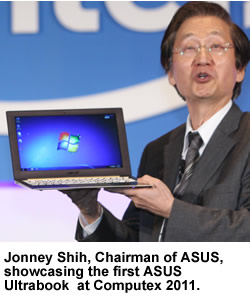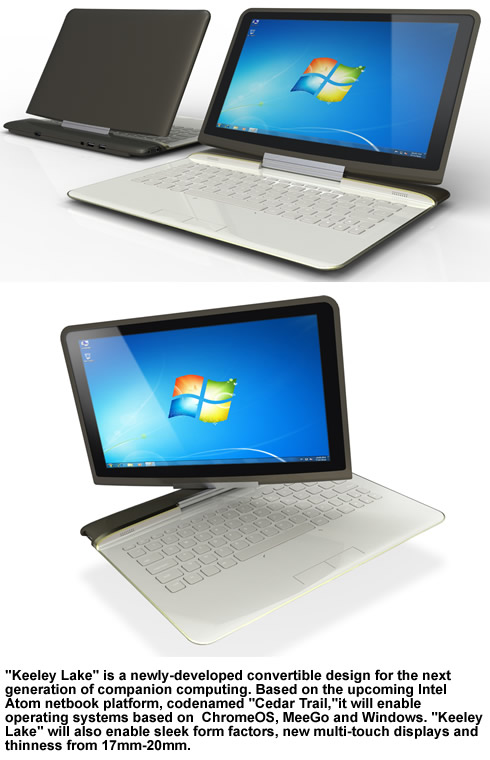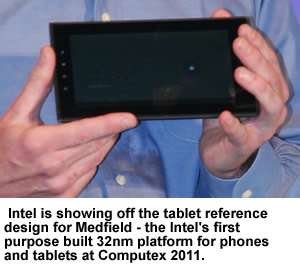
Intel Unveils "Ultrabook" Laptops With Tablet Features at Computex
Intel unveiled a new category of laptops that it says will include the best features of tablets. At the Computex technology exhibition in Taipei Asus showed off its first new PC in the "Ultrabook" class, and Intel said it and models made by other manufacturers would go on sale by Christmas and cost under $1,000.
Intel Executive Vice President Sean Maloney today said that by the end of 2012, 40 percent of the consumer laptop market segment will encompass an emerging new breed of no-compromise computers, called "Ultrabook," which will increasingly combine best-in-class performance, improved responsiveness and security in thin, elegant form factors.
During the opening keynote speech at Computex, one of the world's largest technology trade shows, Maloney provided further details on the significant changes Intel is making to the Intel Core processor roadmap to enable this new category. He also reiterated Intel's push to accelerate the pace of innovation for Intel Atom processor-based system-on-chips (SoCs) for netbooks, smartphones, tablets, and other companion devices.
Intel's vision is to enable a new user experience by accelerating a new class of mobile computers. These computers will marry the performance and capabilities of today's laptops with tablet-like features and deliver a highly responsive and secure experience, in a thin, light and elegant design. The Ultrabook will be shaped by Moore's Law and silicon technology in the same way they have shaped the traditional PC for the past 40 years, aIntel said.
 Maloney described three key phases in the company's strategy to accelerate this vision, which begins to unfold today with the company's latest 2nd Generation Intel Core processors. This family of products will enable thin and light designs that are less than 20mm (0.8 inch) thick, and mainstream price points under US$1,000. Systems based on these chips will be available for the 2011 winter holiday shopping season and include the UX21, ASUS Ultrabook.
Maloney described three key phases in the company's strategy to accelerate this vision, which begins to unfold today with the company's latest 2nd Generation Intel Core processors. This family of products will enable thin and light designs that are less than 20mm (0.8 inch) thick, and mainstream price points under US$1,000. Systems based on these chips will be available for the 2011 winter holiday shopping season and include the UX21, ASUS Ultrabook.
Building on the latest 2nd Generation Intel Core technology, Maloney outlined the next generation Intel processor family codenamed "Ivy Bridge," which is scheduled for availability in systems in the first half of 2012. Laptops based on "Ivy Bridge" will bring improved power efficiency, smart visual performance, increased responsiveness and enhanced security. "Ivy Bridge" is the first high-volume chip based on Intel?s 22 nanometer (nm) manufacturing technology that uses a 3-D transistor design called Tri-Gate announced in May.
Maloney also highlighted complementary USB 3.0 and Thunderbolt technologies which are part of Intel's work to drive the PC platform forward. Intel will integrate USB 3.0 support into its 2012 chipsets, while Thunderbolt technology will continue to appear in more devices and systems.
Following "Ivy Bridge," planned 2013 products codenamed "Haswell" are the third step toward achieving the Ultrabook and reinventing the capabilities of the laptop in ultra thin and light, responsive and more secure designs. With "Haswell," Intel will change the mainstream laptop thermal design point by reducing the microprocessor power to half of today's design point.
Maloney also highlighted key milestones and additional details on upcoming generations of Intel Atom processor-based platforms for tablets, netbooks and smartphones. The Atom processor will outpace Moore's Law, accelerating from 32nm through 22nm to 14nm within 3 successive years.
Reaching its 100 million-unit milestone this month, Intel is preparing its next-generation netbook platform, codenamed "Cedar Trail." "Cedar Trail" is the first netbook platform based on Intel's 32nm technology, and will enable ultra-thin, fanless designs with new capabilities such as Intel Rapid Start technology which provides fast resume, Intel Smart Connect Technology which enables an always updated experience even during standby, Intel Wireless Display and PC Synch, which let users wirelessly update and synchronize documents, content and media across multiple devices. "Cedar Trail"also features improved graphics capabilities including Blu-ray Disc 2.0 support, a dedicated media engine for full 1080p HD playback and additional digital display options including HDMI and DP. In addition, the new platform is expected to enable more than 10 hours of battery life and weeks of standby. "Cedar Trail" will support leading operating systems, such as Microsoft Windows, Google Chrome and MeeGo. New mobile and desktop designs based on the new platform are expected to be released in the second half of 2011.

In addition, Maloney showcased more than 10 tablets, running on three different operating systems, that are available today based on the Intel Atom processor Z670.
 Maloney also discussed "Medfield," Intel's first purpose-built 32nm platform for smartphones and tablets. "Medfield" has been optimized for both low power and high performance and will deliver long use-time, rich media and gaming, and advanced imaging capabilities. To illustrate this point in tablets, Intel showcased a "Medfield" design running Google Android 3.0 ("Honeycomb") for the first time. In production later this year, the platform will enable sub-9mm designs that weigh less than 1.5 pounds for tablet designs in market the first half of 2012. It will support a range of operating systems including Android and MeeGo.
Maloney also discussed "Medfield," Intel's first purpose-built 32nm platform for smartphones and tablets. "Medfield" has been optimized for both low power and high performance and will deliver long use-time, rich media and gaming, and advanced imaging capabilities. To illustrate this point in tablets, Intel showcased a "Medfield" design running Google Android 3.0 ("Honeycomb") for the first time. In production later this year, the platform will enable sub-9mm designs that weigh less than 1.5 pounds for tablet designs in market the first half of 2012. It will support a range of operating systems including Android and MeeGo.
More people and devices connecting to the Internet will lead to growth in cloud-based services for storage, synchronization and entertainment, according to Maloney, and Intel is poised to grow with it. He said that one new Intel-based server is needed for roughly every additional 600 new smartphones or 122 new tablets connecting to the Internet. He also reiterated the company's "Cloud 2015" vision of a world of interoperable "federated" clouds that allow enterprises to share data securely across public and private clouds; "automated" networks that allow the movement of workloads between servers in the data center for better utilization and energy efficiency, and "device-aware" clouds that know what types of applications, commands and processing.
During the opening keynote speech at Computex, one of the world's largest technology trade shows, Maloney provided further details on the significant changes Intel is making to the Intel Core processor roadmap to enable this new category. He also reiterated Intel's push to accelerate the pace of innovation for Intel Atom processor-based system-on-chips (SoCs) for netbooks, smartphones, tablets, and other companion devices.
Intel's vision is to enable a new user experience by accelerating a new class of mobile computers. These computers will marry the performance and capabilities of today's laptops with tablet-like features and deliver a highly responsive and secure experience, in a thin, light and elegant design. The Ultrabook will be shaped by Moore's Law and silicon technology in the same way they have shaped the traditional PC for the past 40 years, aIntel said.
 Maloney described three key phases in the company's strategy to accelerate this vision, which begins to unfold today with the company's latest 2nd Generation Intel Core processors. This family of products will enable thin and light designs that are less than 20mm (0.8 inch) thick, and mainstream price points under US$1,000. Systems based on these chips will be available for the 2011 winter holiday shopping season and include the UX21, ASUS Ultrabook.
Maloney described three key phases in the company's strategy to accelerate this vision, which begins to unfold today with the company's latest 2nd Generation Intel Core processors. This family of products will enable thin and light designs that are less than 20mm (0.8 inch) thick, and mainstream price points under US$1,000. Systems based on these chips will be available for the 2011 winter holiday shopping season and include the UX21, ASUS Ultrabook.
Building on the latest 2nd Generation Intel Core technology, Maloney outlined the next generation Intel processor family codenamed "Ivy Bridge," which is scheduled for availability in systems in the first half of 2012. Laptops based on "Ivy Bridge" will bring improved power efficiency, smart visual performance, increased responsiveness and enhanced security. "Ivy Bridge" is the first high-volume chip based on Intel?s 22 nanometer (nm) manufacturing technology that uses a 3-D transistor design called Tri-Gate announced in May.
Maloney also highlighted complementary USB 3.0 and Thunderbolt technologies which are part of Intel's work to drive the PC platform forward. Intel will integrate USB 3.0 support into its 2012 chipsets, while Thunderbolt technology will continue to appear in more devices and systems.
Following "Ivy Bridge," planned 2013 products codenamed "Haswell" are the third step toward achieving the Ultrabook and reinventing the capabilities of the laptop in ultra thin and light, responsive and more secure designs. With "Haswell," Intel will change the mainstream laptop thermal design point by reducing the microprocessor power to half of today's design point.
Maloney also highlighted key milestones and additional details on upcoming generations of Intel Atom processor-based platforms for tablets, netbooks and smartphones. The Atom processor will outpace Moore's Law, accelerating from 32nm through 22nm to 14nm within 3 successive years.
Reaching its 100 million-unit milestone this month, Intel is preparing its next-generation netbook platform, codenamed "Cedar Trail." "Cedar Trail" is the first netbook platform based on Intel's 32nm technology, and will enable ultra-thin, fanless designs with new capabilities such as Intel Rapid Start technology which provides fast resume, Intel Smart Connect Technology which enables an always updated experience even during standby, Intel Wireless Display and PC Synch, which let users wirelessly update and synchronize documents, content and media across multiple devices. "Cedar Trail"also features improved graphics capabilities including Blu-ray Disc 2.0 support, a dedicated media engine for full 1080p HD playback and additional digital display options including HDMI and DP. In addition, the new platform is expected to enable more than 10 hours of battery life and weeks of standby. "Cedar Trail" will support leading operating systems, such as Microsoft Windows, Google Chrome and MeeGo. New mobile and desktop designs based on the new platform are expected to be released in the second half of 2011.

In addition, Maloney showcased more than 10 tablets, running on three different operating systems, that are available today based on the Intel Atom processor Z670.
 Maloney also discussed "Medfield," Intel's first purpose-built 32nm platform for smartphones and tablets. "Medfield" has been optimized for both low power and high performance and will deliver long use-time, rich media and gaming, and advanced imaging capabilities. To illustrate this point in tablets, Intel showcased a "Medfield" design running Google Android 3.0 ("Honeycomb") for the first time. In production later this year, the platform will enable sub-9mm designs that weigh less than 1.5 pounds for tablet designs in market the first half of 2012. It will support a range of operating systems including Android and MeeGo.
Maloney also discussed "Medfield," Intel's first purpose-built 32nm platform for smartphones and tablets. "Medfield" has been optimized for both low power and high performance and will deliver long use-time, rich media and gaming, and advanced imaging capabilities. To illustrate this point in tablets, Intel showcased a "Medfield" design running Google Android 3.0 ("Honeycomb") for the first time. In production later this year, the platform will enable sub-9mm designs that weigh less than 1.5 pounds for tablet designs in market the first half of 2012. It will support a range of operating systems including Android and MeeGo.
More people and devices connecting to the Internet will lead to growth in cloud-based services for storage, synchronization and entertainment, according to Maloney, and Intel is poised to grow with it. He said that one new Intel-based server is needed for roughly every additional 600 new smartphones or 122 new tablets connecting to the Internet. He also reiterated the company's "Cloud 2015" vision of a world of interoperable "federated" clouds that allow enterprises to share data securely across public and private clouds; "automated" networks that allow the movement of workloads between servers in the data center for better utilization and energy efficiency, and "device-aware" clouds that know what types of applications, commands and processing.





















